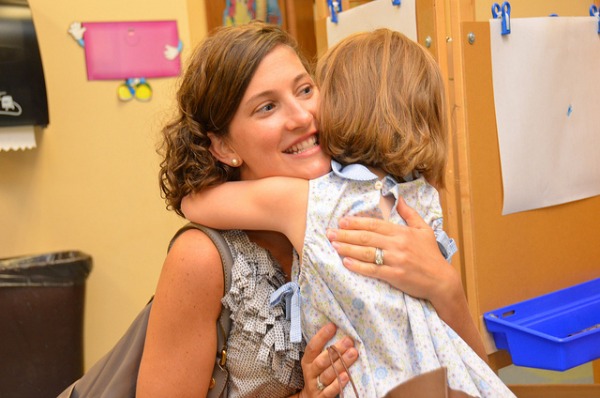“Nena, aquí es donde vas aprender inglés, pero con mami y papi vas a seguir hablando español, ¿okay?” (This is where you are going to learn English, but with mom and dad you’ll continue speaking Spanish, okay?)
“Mami y Papi español.” (Mom and Dad Spanish.)
“Si, en la casita de Sabrina hablamos español.” (Yes, at Sabrina’s home we speak Spanish.)
“Casita español, mami.” (Little house Spanish, mommy.)
I had a knot in my throat and my eyes were beginning to swell up with tears as I kissed my 2 1/2-year old’s forehead. This was her first day in an English immersion setting. From the day she was born her interactions with others (including daycare) occurred +90% of the time in Spanish. I knew that today and the weeks to come marked a new chapter in her life. I knew that it would likely change her. I knew that she would learn English at an extremely fast pace given the amount of exposure she would have — she was also going full-time to daycare for the first time. What I feared most was that our Spanish-speaking relationship would change.
On the bright side (luckily), we learned that her teacher took six years of Spanish through high school and college and that the assistant in the classroom was a heritage speaker of Spanish. Between the two of them they have (today is day 4 of school) openly tried to support our efforts in teaching Sabrina Spanish. So far the teachers have taught the other children in the class to say, hola or adios to Sabrina as she makes her entrance or exit from the class. When I pick her up from daycare she continues to speak to me in Spanish. Just the other day, she was telling her teacher “Es mi mami” and pointing to me.
Most importantly though and I cannot stress this enough, Sabrina is emotionally happy at her new school and, according to her teachers, she is very social and loves to talk to her peers in Spanish. Though I know speaking Spanish to her peers will change the longer she is at her new school, I hope that our well-established Spanish relationship will remain intact. Only time will tell…
To the readers, how has English-immersion schooling gone with your Spanish-speaking children? What are some of the strategies you use to maintain Spanish in your home after exposing your children to an English education?
{Photo by mrchrishill}



hi Suzanne! As i will soon be in the same boat you are (except at home we speak to Enzo in Spanish and French)
i thank you for sharing your experiences here…
i think i might have found the best i could, a daycare that offers an hour of Spanish a day!
I have also decided to start slowly, with two days (or three half days) of daycare a week,
to still give him an opportunity to be with Abuela and our babysitter, who speak to him in Spanish.
Please continue sharing your experiences here!
Buena suerte!
La solucion: TV in Spanish. And not just the novelas I usually let them watch their favorite disney shows and movies in Spanish. Netflix has many available languages as well. We live in Hawaii were there are no more Spanish speaking kids in their preschool but they have already learn Spanish at home (and between them) English outside.
I usually let them watch their favorite disney shows and movies in Spanish. Netflix has many available languages as well. We live in Hawaii were there are no more Spanish speaking kids in their preschool but they have already learn Spanish at home (and between them) English outside.
La solucion: TV in Spanish. And not just the novelas I usually let them watch their favorite disney shows and movies in Spanish. Netflix has many available languages as well. We live in Hawaii were there are no more Spanish speaking kids in their preschool but they have already learn Spanish at home (and between them as well) English outside.
I usually let them watch their favorite disney shows and movies in Spanish. Netflix has many available languages as well. We live in Hawaii were there are no more Spanish speaking kids in their preschool but they have already learn Spanish at home (and between them as well) English outside.
Suzanne,
Can you give us an update and advice? I’m in the same boat now with my 3 year old.
In my opinion, it comes down to % of input & investment (both parents and child). We have been able to raise a bilingual child mostly because she doesn’t know any different. This has been her life since the day she was born. We have been very consistent about the amount of input and how it is received. For example, we have only spoken in Spanish to her.